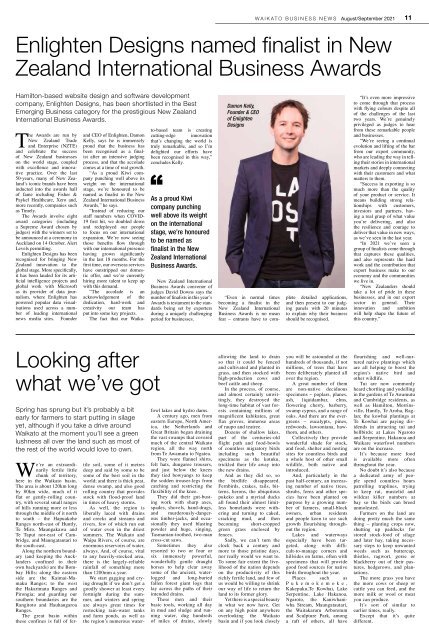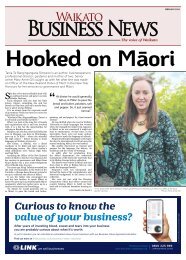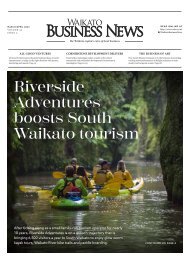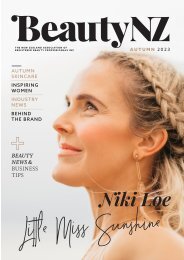Waikato Business News August/September 2021
Waikato Business News has for a quarter of a century been the voice of the region’s business community, a business community with a very real commitment to innovation and an ethos of co-operation.
Waikato Business News has for a quarter of a century been the voice of the region’s business community, a business community with a very real commitment to innovation and an ethos of co-operation.
Create successful ePaper yourself
Turn your PDF publications into a flip-book with our unique Google optimized e-Paper software.
WAIKATO BUSINESS NEWS <strong>August</strong>/<strong>September</strong> <strong>2021</strong><br />
11<br />
Enlighten Designs named finalist in New<br />
Zealand International <strong>Business</strong> Awards<br />
Hamilton-based website design and software development<br />
company, Enlighten Designs, has been shortlisted in the Best<br />
Emerging <strong>Business</strong> category for the prestigious New Zealand<br />
International <strong>Business</strong> Awards.<br />
The Awards are run by<br />
New Zealand Trade<br />
and Enterprise (NZTE)<br />
and celebrate the success<br />
of New Zealand businesses<br />
on the world stage, coupled<br />
with excellence and innovative<br />
practice. Over the last<br />
50-years, many of New Zealand’s<br />
iconic brands have been<br />
inducted into the awards hall<br />
of fame including Fisher &<br />
Paykel Healthcare, Xero and,<br />
more recently, companies such<br />
as Timely.<br />
The Awards involve eight<br />
award categories (including<br />
a Supreme Award chosen by<br />
judges) with the winners set to<br />
be announced at a ceremony in<br />
Auckland on 14 October, Alert<br />
Levels permitting.<br />
Enlighten Designs has been<br />
recognised for bringing New<br />
Zealand innovation to the<br />
global stage. More specifically,<br />
it has been lauded for its artificial<br />
intelligence projects and<br />
global work with Microsoft<br />
as its provider of data journalism,<br />
where Enlighten has<br />
powered popular data visualisations<br />
used across a number<br />
of leading international<br />
news media sites. Founder<br />
and CEO of Enlighten, Damon<br />
Kelly, says he is immensely<br />
proud that the business has<br />
been recognised as a finalist<br />
after an intensive judging<br />
process, and that the accolade<br />
comes at a time of real growth.<br />
“As a proud Kiwi company<br />
punching well above its<br />
weight on the international<br />
stage, we’re honoured to be<br />
named as finalist in the New<br />
Zealand International <strong>Business</strong><br />
Awards,” he says.<br />
“Instead of reducing our<br />
staff numbers when COVID-<br />
19 first hit, we doubled down<br />
and redeployed our people<br />
to focus on our international<br />
expansion. We’re now seeing<br />
those benefits flow through<br />
with our international presence<br />
having grown significantly<br />
in the last 18 months. For the<br />
first time, our overseas services<br />
have outstripped our domestic<br />
offer, and we’re currently<br />
hiring more talent to keep up<br />
with this demand.<br />
“The accolade is an<br />
acknowledgement of the<br />
dedication, hard-work and<br />
creativity our team has<br />
put into some key projects.<br />
The fact that our <strong>Waikato</strong>-based<br />
team is creating<br />
cutting-edge innovation<br />
that’s changing the world is<br />
truly remarkable, and so I’m<br />
delighted our efforts have<br />
been recognised in this way,”<br />
concludes Kelly.<br />
As a proud Kiwi<br />
company punching<br />
well above its weight<br />
on the international<br />
stage, we’re honoured<br />
to be named as<br />
finalist in the New<br />
Zealand International<br />
<strong>Business</strong> Awards.<br />
New Zealand International<br />
<strong>Business</strong> Awards convenor of<br />
judges David Downs says the<br />
number of finalists in this year’s<br />
Awards is testament to the standards<br />
being set by exporters<br />
during a uniquely challenging<br />
period for businesses.<br />
Damon Kelly,<br />
Founder & CEO<br />
of Enlighten<br />
Designs<br />
“Even in normal times<br />
becoming a finalist in the<br />
New Zealand International<br />
<strong>Business</strong> Awards is no mean<br />
feat – entrants have to complete<br />
detailed applications,<br />
and then present to our judging<br />
panels with 20 minutes<br />
to explain why their business<br />
should be recognised.<br />
“It’s even more impressive<br />
to come through that process<br />
with flying colours despite all<br />
of the challenges of the last<br />
two years. We’re genuinely<br />
privileged as judges to hear<br />
from these remarkable people<br />
and businesses.<br />
“We’re seeing a continual<br />
evolution and lifting of the bar<br />
from our export community,<br />
who are leading the way in telling<br />
their stories in international<br />
markets and deeply connecting<br />
with their customers and what<br />
matters to them.<br />
“Success in exporting is so<br />
much more than the quality<br />
of your product or service. It<br />
means building strong relationships<br />
with customers,<br />
investors and partners, having<br />
a real grasp of what value<br />
you’re delivering, and also<br />
the resilience and courage to<br />
deliver that value in new ways,<br />
as we’ve seen in the last year.<br />
“In <strong>2021</strong> we’ve seen a<br />
group of finalists come through<br />
that captures these qualities,<br />
and also represents the hard<br />
work and the contribution that<br />
export business make to our<br />
economy and the communities<br />
we live in.<br />
“New Zealanders should<br />
take a lot of pride in these<br />
businesses, and in our export<br />
sector in general. Their<br />
innovation and ambition<br />
will help shape the future of<br />
this country.”<br />
Looking after<br />
what we’ve got<br />
Spring has sprung but it’s probably a bit<br />
early for farmers to start putting in silage<br />
yet, although if you take a drive around<br />
<strong>Waikato</strong> at the moment you’ll see a green<br />
lushness all over the land such as most of<br />
the rest of the world would love to own.<br />
We’re an extraordinarily<br />
fertile little<br />
chunk of territory,<br />
here in the <strong>Waikato</strong> basin.<br />
The area is about 120km long<br />
by 80km wide, much of it<br />
flat or gently-rolling country,<br />
with several small ranges<br />
of hills running more or less<br />
through the middle of it north<br />
to south – the Hapuakohe<br />
Ranges north-east of Huntly,<br />
Te Miro, Maungakawa and<br />
Te Tapui nor-east of Cambridge,<br />
and Maungatautari to<br />
the south-east.<br />
Along the northern boundary<br />
(and keeping the Aucklanders<br />
confined to their<br />
own backyards) are the Bombay<br />
Hills; along the eastern<br />
side are the Kaimai-Mamaku<br />
Ranges; to the west<br />
the Hakarimata Ranges and<br />
Pirongia; and guarding our<br />
southern boundaries are the<br />
Rangitoto and Hauhangaroa<br />
Ranges.<br />
The great basin within<br />
these confines is full of fertile<br />
soil, some of it metres<br />
deep and said by some to be<br />
some of the best soil in the<br />
world; and there is thick peat,<br />
dense swamp, and also good<br />
rolling country that provides<br />
stock with flood-proof land<br />
in times of heavy storms.<br />
As well, the region is<br />
liberally laced with drains<br />
and creeks and streams and<br />
rivers, few of which run out<br />
of water even in the driest<br />
summers. The <strong>Waikato</strong> and<br />
Waipa Rivers, of course, are<br />
enormous reservoirs of water,<br />
always. And, of course, vital<br />
to any heavily-stocked area,<br />
there is the largely-reliable<br />
rainfall of something more<br />
than 1200mm a year.<br />
We start gagging and crying<br />
drought if we don’t get a<br />
goodly shower at least every<br />
fortnight during the summer,<br />
and winters and spring<br />
are always great times for<br />
restocking rain-water tanks<br />
and farm ponds, as well as<br />
the region’s numerous waterfowl<br />
lakes and hydro dams.<br />
A century ago, men from<br />
eastern Europe, North America,<br />
the Netherlands and<br />
Great Britain began draining<br />
the vast swamps that covered<br />
much of the central <strong>Waikato</strong><br />
region, all the way north<br />
from Te Awamutu to Ngatea.<br />
They wore flannel shirts,<br />
felt hats, dungaree trousers,<br />
and just below the knees<br />
they tied bowyangs to keep<br />
the sodden trouser-legs from<br />
catching and restricting the<br />
flexibility of the knee.<br />
They did their gut-busting<br />
work with sharp axes,<br />
spades, shovels, hand-drags,<br />
and murderously-dangerous<br />
timber-jacks, and occasionally<br />
they used blasting<br />
powder and huge, singing,<br />
Tasmanian-toothed, two-man<br />
cross-cut saws.<br />
Sometimes they also<br />
resorted to two or four or<br />
six immensely powerful,<br />
wonderfully gentle draught<br />
horses to help clear away<br />
some of the ancient, waterlogged<br />
and long-buried<br />
fallen forest giant logs that<br />
lay across the paths of their<br />
intended drains.<br />
These men and their<br />
basic tools, working all day<br />
in mud and sludge and running<br />
water, dug hundreds<br />
of miles of drains, slowly<br />
allowing the land to drain<br />
so that it could be fenced<br />
and cultivated and planted in<br />
grass, and then stocked with<br />
high-production cows and<br />
beef cattle and sheep.<br />
In the process, of course,<br />
and almost certainly unwittingly,<br />
they destroyed the<br />
long-time habitat of vast forests<br />
containing millions of<br />
magnificent kahikatea, great<br />
flax groves, immense areas<br />
of raupo and teatree.<br />
Dozens of shallow lakes,<br />
part of the centuries-old<br />
flight path and food-bowls<br />
of countless migratory birds<br />
including such beautiful<br />
specimens as the kotuku,<br />
trickled their life away into<br />
the new drains.<br />
And as they did so, so<br />
the birdlife disappeared.<br />
Fernbirds, crakes, rails, bitterns,<br />
herons, the ubiquitous<br />
pukeko and a myriad ducks<br />
all found their almost limitless<br />
homelands were withering<br />
and turning to caked,<br />
cracking mud, and then<br />
becoming short-cropped<br />
green grass enclosed by<br />
fences.<br />
Sadly, we can’t turn the<br />
clock back a century and<br />
more to those pristine days,<br />
nor really would we want to.<br />
To some fair extent the livelihood<br />
of the nation depends<br />
on the productivity of this<br />
richly fertile land, and few of<br />
us would be willing to shrink<br />
our way of life to return the<br />
land to its former glory.<br />
Yet there is a special beauty<br />
in what we now have. Get<br />
on any high point anywhere<br />
overlooking the <strong>Waikato</strong><br />
basin and if you look closely<br />
you will be astounded at the<br />
hundreds of thousands, if not<br />
millions, of trees that have<br />
been deliberately planted all<br />
over the region.<br />
A great number of them<br />
are non-native deciduous<br />
specimens – poplars, planes,<br />
ash, liquidambar, elms,<br />
flowering cherry, barberry,<br />
swamp cyprus, and a range of<br />
oaks. And there are the evergreens<br />
– eucalypts, pines,<br />
redwoods, lawsoniana, hawthorn,<br />
and others.<br />
Collectively they provide<br />
wonderful shade for stock,<br />
and food, shelter and nesting<br />
sites for countless birds and<br />
a whole host of other small<br />
wildlife, both native and<br />
introduced.<br />
And, particularly in the<br />
past half-century, an increasing<br />
number of native trees,<br />
shrubs, ferns and other species<br />
have been planted on<br />
purpose by a growing number<br />
of farmers, small-block<br />
owners, urban residents<br />
and people keen to see such<br />
growth flourishing throughout<br />
the region.<br />
Lakes and waterways<br />
especially have been targeted,<br />
along with difficult-to-manage<br />
corners and<br />
hillsides on farms, often with<br />
specimens that will provide<br />
good food sources for native<br />
birds throughout the year.<br />
Places such as<br />
Pukemokemoke,<br />
Kakepuku,Te Kowhai, Lake<br />
Serpentine, Lake Hakanoa,<br />
Ngaroto, the Kaniwhaniwha<br />
Stream, Maungatautari,<br />
the Waitakaruru Arboretum<br />
and Sculpture Park, among<br />
a raft of others, all have<br />
flourishing and well-nurtured<br />
native plantings which<br />
are all helping to boost the<br />
region’s native bird and<br />
other wildlife.<br />
Tui are now commonly<br />
heard chortling and yodelling<br />
in the gardens of Te Awamutu<br />
and Cambridge residents, as<br />
well as Hamilton, Morrinsville,<br />
Huntly, Te Aroha, Raglan;<br />
the kowhai plantings at<br />
Te Kowhai are paying dividends<br />
in attracting tui and<br />
bellbirds; at Lakes Ngaroto<br />
and Serpentine, Hakanoa and<br />
Waikare waterfowl numbers<br />
are on the increase.<br />
It’s because more food<br />
is available more often<br />
throughout the year.<br />
No doubt it’s also because<br />
a dedicated army of people<br />
spend countless hours<br />
patrolling traplines, trying<br />
to keep rat, mustelid and<br />
wildcat killer numbers at<br />
bay so the birds can breed<br />
unmolested.<br />
Farmers on the land are<br />
doing pretty much the same<br />
thing – planting crops now,<br />
shutting up paddocks for<br />
stored stock-food of silage<br />
and later hay, taking necessary<br />
steps to keep unwanted<br />
weeds such as buttercup,<br />
thistles, ragwort, gorse or<br />
blackberry out of their pastures,<br />
hedgerows, and plantations.<br />
The more grass you have<br />
the more cows or sheep or<br />
cattle you can feed, and the<br />
more milk or wool or meat<br />
you can produce.<br />
It’s sort of similar to<br />
earlier times, really.<br />
Except that it’s quite<br />
different.


















